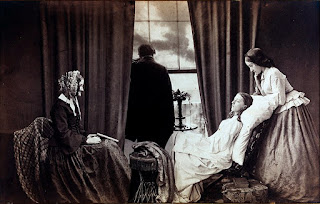Run round and round a Room –
In search of Something – as it seemed –
Then Cloudier become –
And then – obscure with Fog –
And then – be soldered down
Without disclosing what it be
'Twere blessed to have seen –
Fr 648 (1863) J547
The living have no way to really know what happens after death. There are the usual reports from the near dead or briefly dead: the tunnel with a light at the end, for example; or the evanescing (or perhaps effervescing) into the vast Oneness of the Cosmos. But we tend to take these tales with a grain of salt. The brain might be doing strange things as it closes down. We may be conditioned to expect certain outcomes and, thus, imagine we've seen them.
In this poem, the speaker waits by a death bed or death beds hoping the dying person will provide some indication of what might be glimpsed as he or she passes through the veil separating life from death. But no such indication is forthcoming.
It's a poem of frustration rather than grief. The speaker details the Eye's movements in the last moments, but it is clear it is not clinical curiosity about what an eye does before becoming "soldered down" with death, but rather curiosity about what the eye sees as the body dies. There is, however, no indication that dying Eyes see anything of note. They become cloudy, then obscured, and then, finally, closed in the finality of death. The poem ends with the speaker frustrated that nothing has been revealed, but Dickinson seems to imply that the dying are not "blessed to have seen" anything.
 |
| Fading Away, Henry Robinson: Victorian deathbed watch |
In another poem's death scene frustration, a dying person "heard a Fly buzz" when she died rather than seeing "the King," undoubtedly Jesus or some other representation of God or the divine, that those gathered around her were clearly expecting. Instead she sees only a fly as her "Windows failed." The incongruous and existential disparity between savior and fly in this poem (Fr591) is profound.
Dickinson refrains from the hushed respect accorded death bed watches. While the buzzing blue fly is an almost sarcastic dismissal of hopes for a divine encounter, Sharon Leiter says that the Dying Eye's searching in the current poem "suggests nothing so much as a demented rodent of some sort racing desperately in circles' (Critical Companion to Emily Dickinson, 2007, p. 133). I don't think that Dickinson is dismissing the mysteries of life and death but rather depicting the vagaries, indignities, and ultimately the singularly alone-ness of the passage.
Dickinson compresses two stanzas in this poem, using traditional hymn or ballad style. She further knits the poem together with word sounds. The 'ou's of "round and round" are echoed in "Cloudier" and 'Without". The rodent quickness is impelled by the "r"s of "Run round and round a Room" followed by the sibilance of "In search of Something – as it seemed – ." "Dying Eye" not only has a core rhyme but the visual element of the "y," and most of the end words can be sorted into two slant rhyme groups: Room, seemed, become; and seemed, be, and seen (plus down with seen).
But the heart of the poem lies in the center as the poet builds to the final anticlimax. She begins with the Dying Eye searching, followed by three listings: Then it becomes cloudy; and then obscured; and then it is soldered down. Hope diminishes with each step into the final ironic subjunctive.

